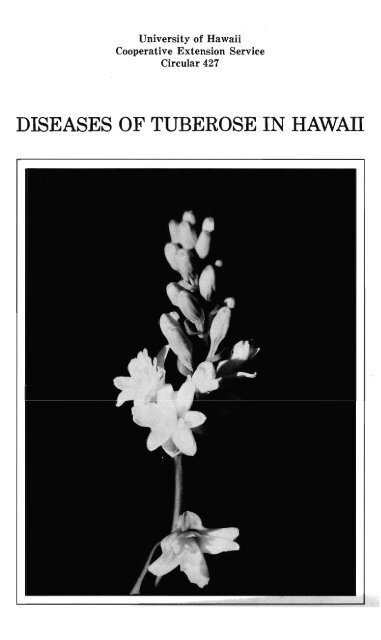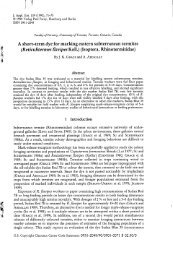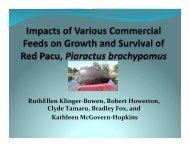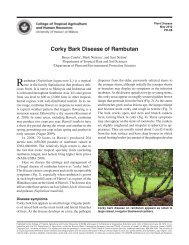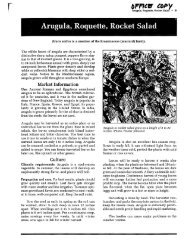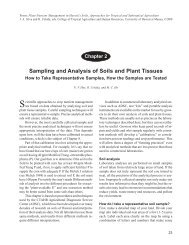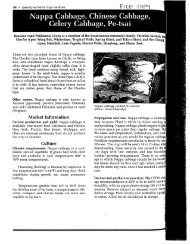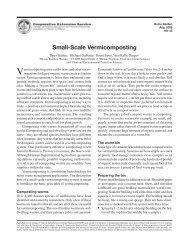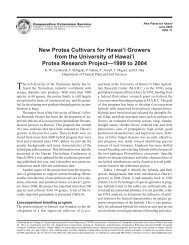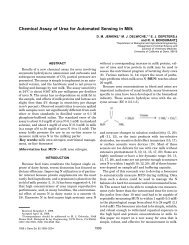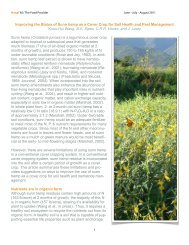DISEASES OF TUBEROSE IN HAWAII - ctahr - University of Hawaii
DISEASES OF TUBEROSE IN HAWAII - ctahr - University of Hawaii
DISEASES OF TUBEROSE IN HAWAII - ctahr - University of Hawaii
You also want an ePaper? Increase the reach of your titles
YUMPU automatically turns print PDFs into web optimized ePapers that Google loves.
<strong>University</strong> <strong>of</strong> <strong>Hawaii</strong><br />
Cooperative Extension Service<br />
Circular 427<br />
<strong>DISEASES</strong> <strong>OF</strong> <strong>TUBEROSE</strong> <strong>IN</strong> <strong>HAWAII</strong>
<strong>DISEASES</strong> <strong>OF</strong> <strong>TUBEROSE</strong> <strong>IN</strong> <strong>HAWAII</strong><br />
E. E. TRUJILLO<br />
Tuberose, Polianthes tuberosa L. <strong>of</strong> Mexican origin, is cultivated in<br />
<strong>Hawaii</strong> for its fragrant, white, waxy flowers used to make leis. The<br />
plant is propagated by transplanting daughter tubers from older<br />
plants. This form <strong>of</strong> vegetative propagation favors the spread <strong>of</strong><br />
many diseases. A number <strong>of</strong> fungus, bacteria, virus, and nematode<br />
diseases are spread in and on tubers, bulbs, or rhizomes <strong>of</strong> vegetatively<br />
propagated ornamentals (2, 6, 7, 8).<br />
While many growers <strong>of</strong> tuberose in <strong>Hawaii</strong> fumigate the soil with<br />
450 pounds <strong>of</strong> methyl bromide (MC-2) per acre, this praetice by itself<br />
has little or no effect in the control <strong>of</strong> diseases which are tuber-borne.<br />
Usually the beneficial effects <strong>of</strong> soil fumigation are lost when a grower<br />
plants diseased tubers or tubers contaminated with disease-causing<br />
microorganisms in clean soil.<br />
Because little is known <strong>of</strong> tuberose, investigations were initiated at<br />
the <strong>Hawaii</strong> Agricultural Experiment Station to study the problems<br />
<strong>of</strong> the crop. Of the three serious diseases <strong>of</strong> tuberose found in <strong>Hawaii</strong>,<br />
two are caused by parasitic nematodes and one by a fungus. Of the<br />
two minor diseases, one is caused by an insect and bacterium and one<br />
by insects alone.<br />
3
Greasy Streak<br />
DESCRIPTION <strong>OF</strong> THE <strong>DISEASES</strong><br />
The foliar nematode, Aphelenchoides besseyi Christie, causes a<br />
greasy leaf streak that rapidly rots the foliage in wet, warm weather<br />
(5). Early symptoms are rather restricted to small water-soaked spots<br />
near the midrib. These spots enlarge along the midrib, causing elongated,<br />
black, greasy spots measuring from 2 to 6 inches long (Fig. 1).<br />
Spots this size or larger cause the leaf to bend, wilt, and dry (Fig. 2).<br />
Nematodes are usually found in great abundance at the margin <strong>of</strong><br />
the spots.<br />
Figure 1. Tuberose leaves showing Figure 2. Leaf bending, wilting, and<br />
typical symptoms <strong>of</strong> black greasy black greasy rotting caused by severe<br />
streak caused by A. besseyi. infestation <strong>of</strong> A. besseyi.<br />
4
Root-knot Nematode<br />
Symptoms <strong>of</strong> root swelling and galling are similar to those described<br />
for other host plants infected with the root-knot nematode.<br />
Affected plants are usually stunted and leaves become yellow at the<br />
tip when the root system is heavily galled (Fig. 3, 4). The nematode,<br />
Meloidogyne sp., that causes this disease can be carried in galled tubers<br />
or contaminated soil from infested beds.<br />
Figure 3. Symptoms <strong>of</strong> root swelling and galling caused by the<br />
root-knot nematode.<br />
Figure 4. Severe stunting <strong>of</strong> tuberose plant at left, caused by<br />
high infectation <strong>of</strong> Meloidogyne species on the root system.<br />
5
Stem Rot<br />
Stem rot caused by Sclerotium rolfsii Sacc. can be a serious problem<br />
on tuberose during warm, wet weather. This is a new disease (1)<br />
characterized by sudden wilting and collapsing <strong>of</strong> the crown leaves at<br />
the soil level and rotting <strong>of</strong> the flower stalk (Fig. 5). The fungus that<br />
causes this disease produces abundant cottony growth on the collapsed<br />
leaves, forming a large number <strong>of</strong> sclerotia which resemble cabbage<br />
seeds. These round bodies are first white, turn brown, and serve as a<br />
rapid means <strong>of</strong> identification (Fig. 6). These sclerotia persist during<br />
unfavorable periods, allowing the fungus to survive and also providing<br />
the means by which the organism can be spread.<br />
Figure 5. Plant at right. Sudden wilting and collapsing <strong>of</strong> the<br />
leaves at the crown level are typical symptoms <strong>of</strong> stem rot.<br />
Figure 6. Basal portion <strong>of</strong> tuberose stalk<br />
covered with the minute sclerotia <strong>of</strong> S. rolfsii,<br />
cause <strong>of</strong> stem rot.<br />
6
Flower Bud Rot<br />
Erwinia sp. is involved in a bacterial rot <strong>of</strong> flower buds that occurs<br />
during warm, wet periods. This bacterial blight is associated with an<br />
unidentified insect vector that lays eggs on the flowers at the bud stage<br />
(Fig. 7). Usually, as the eggs hatch, the s<strong>of</strong>t rot bacteria become<br />
active and rot the tissues while the insect larvae develop.<br />
Figure 7. Tuberose flowers showing symptoms <strong>of</strong> bud rot.<br />
7
Rusty Flower<br />
During warm, wet weather populations <strong>of</strong> the <strong>Hawaii</strong>an thrips,<br />
Thrips hawaiianses Morgan, build up to extremely large numbers on<br />
tuberose flowers, causing injury to the petals. Beginning symptoms<br />
are yellow-brown spots on a white background, and when damage is<br />
severe the whole flower shrivels and turns rusty brown (Fig. 8).<br />
Figure 8. Rusty flower symptoms caused by feeding <strong>of</strong> the<br />
<strong>Hawaii</strong>an thrip.<br />
8
CONTROL<br />
Hot-water treatment has been used effectively to eradicate parasitic<br />
nematodes from vegetatively propagated ornamentals (3, 4, 6). Preliminary<br />
tests with dormant tuberose tubers showed that tuberose<br />
can withstand temperatures above 50°C for more than 10 minutes.<br />
Temperatures <strong>of</strong> 46 to 50°C are necessary to kill root-knot nematodes<br />
(2,9), and foliar nematodes (3) that are present in diseased planting<br />
material. Nematode-infested dormant tuberose tubers were hot-water<br />
treated at 50 and 55°C for 10 to 20 minutes. These tubers were planted<br />
in beds fumigated with methyl bromide at 450 pounds per acre. For<br />
control infected, untreated tubers were used. Six months after planting<br />
the root systems <strong>of</strong> the surviving plants were examined. All tubers<br />
treated at 50 and 55°C survived; the root system showed no root-knot<br />
nematode and the plants were free <strong>of</strong> foliar nematode damage (Fig. 9).<br />
Figure 9. Tuberose plant grown from hot-water treated tubers six months<br />
after planting in MC-2 fumigated soil, showing a vigorous and healthy root<br />
system and foliar growth. '<br />
9
The control plants showed 100 percent root-knot nematode infection<br />
and 30 percent <strong>of</strong> the plants had foliar nematode (Fig. 10). The flower<br />
production on treated plants increased fourfold as 'compared with<br />
the controls (Table 1). Tubers showing severe root-knot nematode<br />
infection were also hot-water treated after trimming all infected<br />
areas. Severely trimmed tubers survived the hot-water treatment;<br />
however, root production was delayed and growth was not resumed<br />
in more than 50 percent <strong>of</strong> them.<br />
Table 1 Effects <strong>of</strong> hot-water treatment on the control <strong>of</strong> root-knot nematodes<br />
affecting tuberose planting six months after planting in fumigated beds<br />
Treatment<br />
Time<br />
Temperature<br />
in °c<br />
Tuber<br />
Survival<br />
Nematode<br />
Survival<br />
No. <strong>of</strong> Flower<br />
Stalks/Hill<br />
10 50 100% 0% 4<br />
10 55 100% 0% 4<br />
20 50 100% 0% 4<br />
Control 100% 100% 1<br />
Figure 10. Tuberose plant grown from tubers not treated with hot water<br />
six months after planting in MC-2 fumigated soil, showing severe root-knot<br />
nematode damage <strong>of</strong> the root system and dried, bent, black leaves, typical<br />
damage <strong>of</strong> the foliar nematode.<br />
10
These tests demonstrated that cleaning and selection <strong>of</strong> tubers<br />
coupled with hot-water treatment could significantly reduce nematode<br />
infestation and increase flower production. Therefore, the following<br />
recommendations are made for control <strong>of</strong> the three major diseases<br />
<strong>of</strong> tuberose:<br />
Soil preparation<br />
1. Till and allow all plant residue to rot before fumigation.<br />
2. Fumigate beds with IIIethyl bromide at 450 pounds per acre<br />
under plastic tarpaulin. Moist soils in seed-bed condition produce<br />
best results.<br />
3. Remove plastic tarpaulins 48 to 72 hours later.<br />
4. Broadcast, fumigate the planting fields by overlapping the<br />
tarpaulin.<br />
5. Plant selected hot-water treated tubers.<br />
Hot-water treatment<br />
1. A constant temperature hot-water bath manufactured to specifications<br />
is recommended. A model similar to the Blue M.<br />
Magrin-Whirl constant temperature with a 17.0-gallon capacity<br />
supplied by various scientific supply houses is adequate for the<br />
commercial grower. Otherwise, water can be heated on the<br />
kitchen stove. When desired temperature is obtained, by constant<br />
stirring <strong>of</strong> the water and alternate heating, the temperature can<br />
be maintained at the desired level. Always check water temperature<br />
at I-minute intervals with a reliable thermometer.<br />
2. Select large tubers with minimum basal rot and other disease<br />
symptoms.<br />
3. Treat dormant tubers at 55°C (122°F) for 10 to 15 minutes in<br />
a constant temperature hot-water bath containing 14 ounce <strong>of</strong><br />
Panogen (2.2 percent methylmercury dicyandiamide) to 5 gallons<br />
<strong>of</strong> water.<br />
4. Dust tubers with PCNB (Pentachloronitrobenzene), Terraclor,<br />
dust after treatment to control Sclerotium rolfsii.<br />
Post-plant treatment<br />
Stem-rot blight may occur in new plantings in spite <strong>of</strong> fumigation<br />
and hot-water treatment. Whenever symptoms <strong>of</strong> this disease become<br />
apparent, drench soil around plants with 14 pound <strong>of</strong> PCNB in water<br />
for every 1,000 square feet <strong>of</strong> bed.<br />
For the control <strong>of</strong> foliar nematodes in growing plants apply two<br />
or three sprays with parathion 25 percent wettable powder at 21/2<br />
11
pounds per 100 gallons <strong>of</strong> water every 7 days, or Systox at a rate <strong>of</strong> 1<br />
quart <strong>of</strong> 42 percent Systox to 100 gallons <strong>of</strong> water every 10 to 12 days.<br />
Insect control<br />
Control <strong>of</strong> the insect vector with Malathion or Dibrom at:1 pound<br />
per 100 gallons <strong>of</strong> water provides effective control <strong>of</strong> the flower rot<br />
caused by Erwiniasp. Weekly sprays with Malathion or Dibrom<br />
control also the <strong>Hawaii</strong>an thrips, cause <strong>of</strong> the rusty flower.<br />
12
LITERATURE CITED<br />
1. AYCOCK, ROBERT. 1966. Stem rot and other diseases caused by Sclerotium<br />
rolfsii. <strong>University</strong> <strong>of</strong> North Carolina Agricultural Experiment Station Technical<br />
Bulletin 174: 202 pp.<br />
2. CHRISTIE, R. J. 1959. Plant nematodes their bionomics and control. <strong>University</strong><br />
<strong>of</strong> Florida Agricultural Experiment Station. 256 pp.<br />
3. FEDER, W. A. 1951. Yellow bud blight, a disease <strong>of</strong> Vanda Joaquim in <strong>Hawaii</strong>.<br />
<strong>University</strong> <strong>of</strong> <strong>Hawaii</strong> Agricultural Experiment Station, Progress Note<br />
62, 5 pp. (mimeographed).<br />
4. GUBA, E. F., and C. J. GIL,GOUT. 1938. Control <strong>of</strong> the begonia leaf-blight<br />
nematode. Massachusetts Agricultural Experiment Station. Bulletin 348.<br />
5. HOLTZMANN, O. V. 1968. A foliar disease <strong>of</strong> tuberose caused by Aphelenchoides<br />
besseyi. Plant Disease Reporter 52: 56.<br />
6. JENSEN, H. J., and E. E. CAVENESS. 1954. Hot-water treatment and Systox<br />
for control <strong>of</strong> foliar nematodes in Bellingham hybrid lilies. Plant Disease Reporter<br />
38: 181-184.<br />
7. ROISTACHER, C. N., K. F. Baker, and J. G. Bald. 1957. Hot-water treatment<br />
<strong>of</strong> gladiolus cormels for the eradication <strong>of</strong> Fusarium oxysporum f. gladioli.<br />
Hilgardia 26: 659-684.<br />
8. TRUJILLO, EDUARDO E. 1964. Diseases <strong>of</strong> ginger (Zingiber <strong>of</strong>ficinale) in <strong>Hawaii</strong>.<br />
<strong>University</strong> <strong>of</strong> <strong>Hawaii</strong> Agricultural Experiment Station Circular 62: 14.<br />
9. TRUJILLO, EDUARDO E. 1964. Clean banana rhizome certification. <strong>Hawaii</strong><br />
Farm Science 16: 8-9.<br />
NOTE<br />
The information contained in this publication is supplied with the<br />
understanding that the College <strong>of</strong> Tropical Agriculture, <strong>University</strong> <strong>of</strong><br />
<strong>Hawaii</strong>, does not intend any endorsement <strong>of</strong> a specific product, nor is<br />
discrimination intended toward any product mentioned in or omitted<br />
from this publication.<br />
13
Cooperative Extension Work in Agriculture and Home Economics<br />
College <strong>of</strong> Tropical Agriculture, <strong>University</strong> <strong>of</strong> <strong>Hawaii</strong>, Honolulu, <strong>Hawaii</strong> 96822<br />
United States Department <strong>of</strong> Agriculture Cooperating<br />
C. Peairs Wilson, Director, <strong>Hawaii</strong> Cooperative Extension Service<br />
Distributed in Furtherance <strong>of</strong> the Acts <strong>of</strong> Congress <strong>of</strong> May 8 and June 30, 1914<br />
CIRCULAR 427-NOVEMBER 1968


